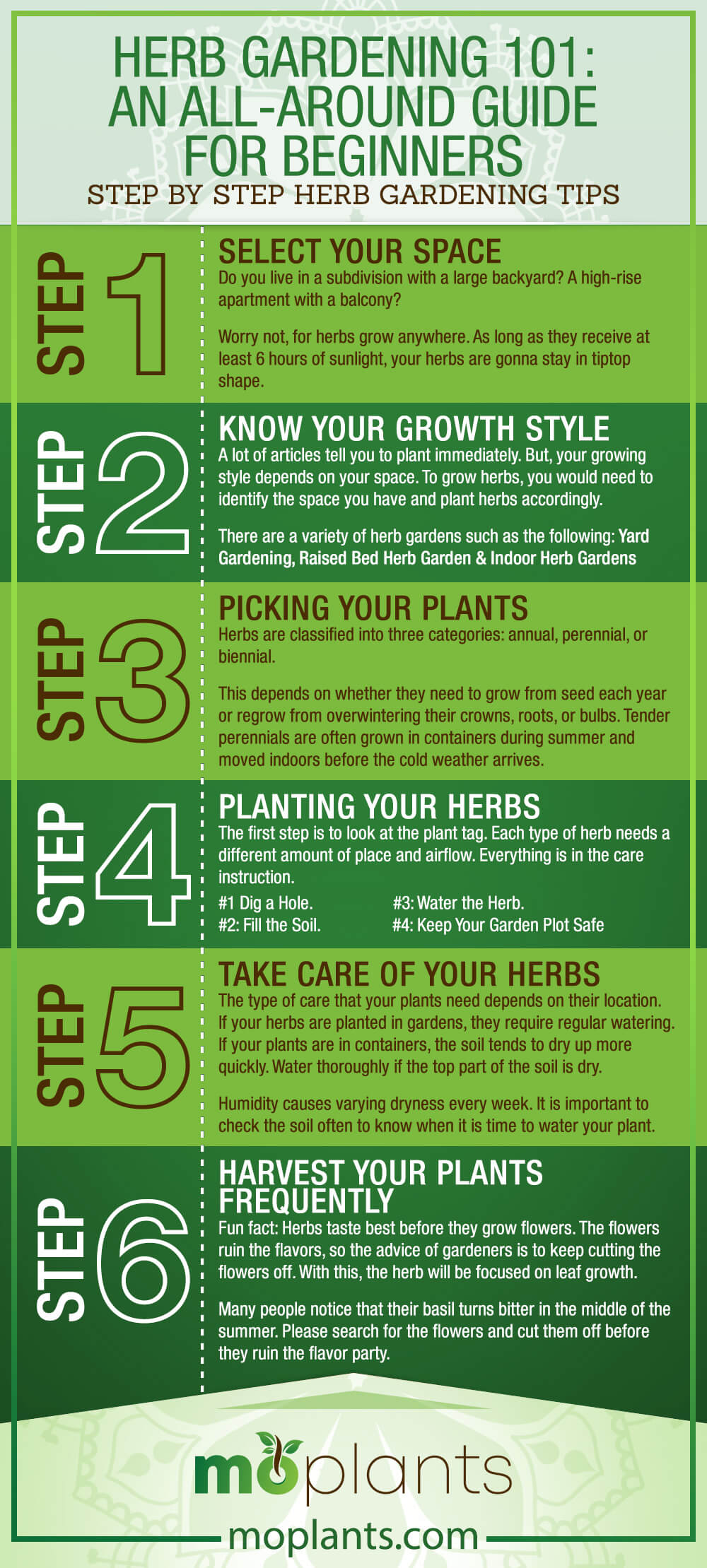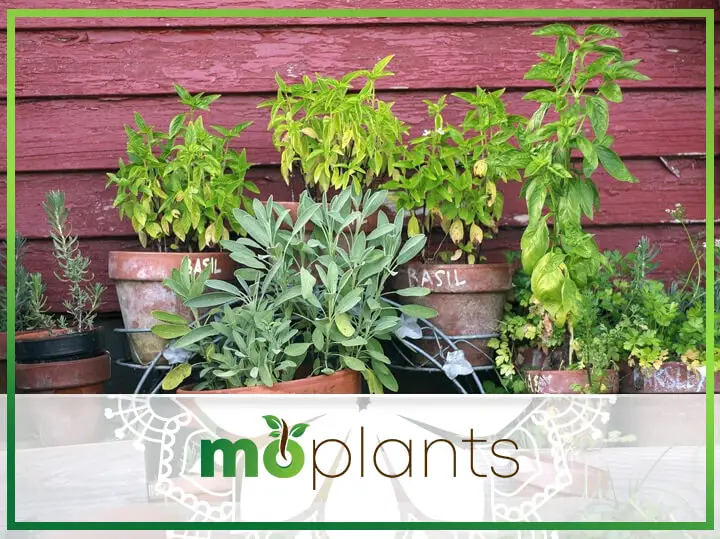From being garnish for dinner to brewing your own tea, there are many reasons to start an herb garden. Herbs are beginner-friendly because they grow in a variety of conditions.
If you are thinking of trying out herb gardening, continue reading, and let’s get growing!
Things You Will Need
First, you would need materials for your herb garden. The following are products to start your journey as an herb gardener:
- Ample space (pots/raised bed gardens, etc.)
- Potting soil
- Watering can
- Compost or vegetable fertilizer
With millions of information to use, we have narrowed your options for the best products. Click on the links above.
Next, grab your garden fork to start the growing process.
Step 1: Select Your Space
The most important requirement for growing herbs is the proper location.
Do you live in a subdivision with a large backyard? A high-rise apartment with a balcony?
Worry not, for herbs grow anywhere. As long as they receive at least 6 hours of sunlight, your herbs are gonna stay in tiptop shape.
If your space is a bit shady, don’t fret. Search for cilantro, parsley, and mint, herbs that are fine with only 3-4 hours of sunlight.
Different herbs require different care.
Don’t forget to place your herbs where you can easily see them. This way, you can notice if they need watering or if pests are starting to invade.
Step 2: Know Your Growth Style
A lot of articles tell you to plant immediately. But, your growing style depends on your space. To grow herbs, you would need to identify the space you have and plant herbs accordingly.
There are a variety of herb gardens such as the following:
Yard Gardening
If you have outdoor space, make sure there is rich soil with a good drainage system.
It is important to look out for competing trees and shrubs. Place your herbs where they would not compete with other plants.
Raised Bed Herb Garden
Raised beds are also called garden boxes. If your soil is heavy, consider planting your herbs on raised beds.
This type of garden provides more growth space and better drainage.
There are also fewer weeds and less soil erosion.
Herbs that are best put in raised beds are chives, mint, and oregano.
Indoor Herb Gardens
If you have a little more space inside your home, consider using pots to grow your plants.
A few square feet outside your kitchen window or along with the patio also works too, especially if you want to snip fresh herbs for your meal.
Woody stems such as rosemary, sage, marjoram, oregano, and parsley are appropriate for indoor gardening.
These plants usually need dry soil and lots of sunshine.
Other herb gardens include medieval and medicinal herb gardens, fragrant herb gardens, and kitchen herb gardens.
Step 3: Picking Your Plants
Herbs are classified into three categories: annual, perennial, or biennial.
This depends on whether they need to grow from seed each year or regrow from overwintering their crowns, roots, or bulbs.
Tender perennials are often grown in containers during summer and moved indoors before the cold weather arrives.
As a beginner gardener, you may choose herb plants that have culinary and aromatic purposes.
A lot of herbs also have ornamental value in your herb garden. Their texture blends well with other plants.
Most herbs make attractive hedges, ground covers, or edges along walkways. They can also be classified according to their flavors as either robust or fine (mild) herbs.
Robust herbs have rich flavor and are often used alone or with other herbs. Some examples are rosemary, thyme, sage, and garlic.
Fine herbs are added toward the end of the cooking process. These are usually eaten with salads like dill, basil, and parsley. Think of what you like to cook and try adding it to your garden.
Why You Should Start With Plants Instead of Seeds
One common mistake beginners make is growing their plant from the seed.
While it is nice to plant seeds, other herbs take a long time to germinate. They need to keep growing indoors before it is time to plant them outside.
Experienced gardeners recommend adding starter plants to the collection.
If you like cooking, add herbs that are found in classic recipes such as rosemary, marjoram, thyme, oregano, and savory.
If you like drinking tea, try chamomile, lavender, and tarragon.
If you have pets at home, your furry friends will adore catnips and pet grass.
For less than the price of a pack of seeds, starter plants are sure to ease you into growing herbs.
Basil: The Beginner’s Bestfriend
You can never go wrong with basil.
Basil is the perfect training herb as it is easy to grow and does not require frequent watering.
Basil is a plant that can take a little abuse.
Not to mention that it is versatile in kitchen recipes.
To plant, pick a good location with full sun.
Basils are also container gardening-friendly. It thrives in well-drained soil and at least 8 inches of container depth for its growth.
Other herbs that gardeners recommend are:
- Mint
- Chives
- Parsley
- Rosemary
- Thyme
- Dill
Step 4: Planting Your Herbs
The first step is to look at the plant tag.
Each type of herb needs a different amount of place and airflow.
Everything is in the care instruction.
#1: Dig a Hole.
Whether you are planting outside or in pots, plant the herbs to the same depth as it was in their containers.
A well-prepped garden goes a long way. Make sure that the soil is turned over and has digested compost.
Avoid garden soil like topsoil or black earth because they are heavy and do not dry easily.
Use potting soil for maximum herb growth.
#2: Fill the Soil.
Fill in the soil around the plant and tap the soil around the herb.
#3: Water the Herb.
Remember to water just enough for the top part of the soil to be moist.
#4: Keep Your Garden Plot Safe
Some herbs take over the garden when planted with other herbs.
Herbs like mint and oregano are known for their aggressiveness.
Consider planting these herbs in pots and burying them in the ground.
The downside in planting in pots is, they will need frequent watering. This is not the case for plants that are planted on the ground.
How to Take Cuttings
If you have a friendly gardener in your neighborhood who offered to give you some cuttings, then it’s a great way to start your herb garden as well.
The following are the steps to take cuttings:
- Select stem segments that are tender and 3″-6″ long with at least five leaves along the stem. Make an angled cut just above a leaf node.
- Remove the lower leaves on the stem and plant it about 2″ deep in a 4″ pot of moist potting soil.
- Cover the cuttings loosely with a plastic bag to increase humidity and place them away from direct sun exposure.
- Water the plants as needed. Remove the plastic bag if there is too much moisture.
- After a few weeks, check for new leaf growth and repot the plants into larger containers with regular potting soil.
- Gradually expose the plants to full sun.
Step 5: Take Care of Your Herbs
The type of care that your plants need depends on their location.
If your herbs are planted in gardens, they require regular watering.
If your plants are in containers, the soil tends to dry up more quickly. Water thoroughly if the top part of the soil is dry.
Humidity causes varying dryness every week. It is important to check the soil often to know when it is time to water your plant.
Remember, overwatering is as bad as underwatering.
Check your plants daily. Some plants tend to become heavier as they grow. Some herbs need to be staked for additional support.
Use mulches to fertilize the herb garden, conserve soil moisture, and reduce weeds.
Step 6: Harvest Your Plants Frequently
Fun fact: Herbs taste best before they grow flowers.
The flowers ruin the flavors, so the advice of gardeners is to keep cutting the flowers off. With this, the herb will be focused on leaf growth.
Many people notice that their basil turns bitter in the middle of the summer. Please search for the flowers and cut them off before they ruin the flavor party.
Harvest in the morning using a pair of garden shears or kitchen scissors.
Never remove more than one-third of the plant. Cut close to the leaf intersection when the herb reaches at least 6″-8″tall.
Infographic

Final Words
We hope you enjoyed these gardening tips.
If you are interested to know more about the many herbs and how to care for them, subscribe to our email newsletter by entering your email address below.

